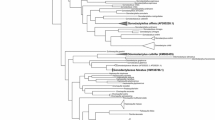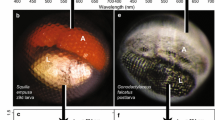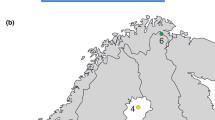Abstract
Compound eyes of the stomatopod, Gonodactylus oerstedii, exhibit pupillary reflection responses which arise from migration of retinular cell pigment granules. In the light, reflectance from the eye increases as pigment granules accumulate around light-sensitive rhabdoms and scatter incoming light back out of the eye (pupillary closure). At dark onset, reflectance diminishes as pigment granules disperse centrifugally, enhancing photon capture by the rhabdom. We investigated the mechanisms of the pupillary response in intact animals by measuring reflectance from the eye under different temperature conditions. Lowering the temperature from 27° to 7 °C caused an increase in reflectance of infrared light in the absence of visible-light stimuli, indicating pupillary closure. When given light stimuli as temperature decreased, the eye continued to produce reflection increases which decreased in amplitude as the between stimulus reflectance level increased. All low-temperature effects were reversed when temperature was increased to normal. The rate of pupillary closure was insensitive to temperature, with a temperature quotient (Q10) of 0.8 ± 0.1 s.e.m, while pupillary opening was extremely temperature sensitive (Q10 of 5.4 ± 0.4). Different temperature sensitivities for pupillary opening and closing suggest that these processes involve different mechanisms.
Similar content being viewed by others
Abbreviations
- IOP:
-
intracelllular optical physiology
- Q10 :
-
temperature quotient
References
Autrum H (1981) Light and dark adaptation in invertebrates. In: Autrum H (ed) Comparative physiology and evolution of vision in invertebrates: Invertebrate visual centers and behavior II. (Handbook of sensory physiology Vol. VII/6C) Springer, Berlin Heidelberg New York, pp 2–91
Bernard GD, Stavenga DG (1979) Spectral sensitivities of retinular cells measured in intact living bumblebees by an optical method. Naturwissenschaften 65: 442–443
Bernard GD, Wehner R (1980) Intracellular optical physiology of the bee's eye.I. Spectral sensitivity. J Comp Physiol 137: 193–203
Cronin TW (1989) Application of intracellular optical techniques to the study of stomatopod crustacean vision. J Comp Physiol A 164: 737–749
Cronin TW, King CA (1989) Spectral sensitivity in the mantis shrimp Gonodactylus oerstedii determined using noninvasive optical techniques. Biol Bull 176: 308–316
Exner S (1891) Die Physiologie der facettierten Augen von Krebsen und Insekten [The Physiology of Compound Eyes of Insects and Crustaceans]. Hardie RC (Transl) 1989. Springer, Berlin Heidelberg New York
Franceschini N (1975) Sampling of the visual environment by the compound eye of the fly: Fundamentals and applications. In: Snyder AW, Menzel R (eds) Photoreceptor optics. Springer, Berlin Heidelberg New York, pp 98–125
Howard J (1984) Calcium enables photoreceptor pigment migration in a mutant fly. J Exp Biol 113: 471–475
King CA, Cronin TW (1989) Ultrastructural evidence for the pupillary response in stomatopod photoreceptors: cytoskeleton and orientation of pigment granules. Invest Ophthalmol Visual Sci 30 (Suppl): 292
King CA, Cronin TW (1993) Cytoskeleton of retinular cells from the stomatopod, Gonodactylus oerstedii: possible roles in pigment granule migration. Cell Tissue Res 274: 315–328
King CA, Cronin TW (1994) Investigations of pigment granule transport systems in the stomatopod, Gonodactylus oerstedii (Crustacea: Hoplocarida: Stomatopoda) II. Effects of low temperature on pigment granule position and microtubule populations in retinular cells. J Comp Physiol A 175: 331–342
Kirschfeld K, Franceschini N (1969) Ein Mechanismus zur Steuerung des Lichtflusses in den Rhabdomeren des Komplexauges von Musca. Kybernetik 6: 13–22
Kirschfeld K, Vogt K (1980) Calcium ions and pigment granule migration in fly photoreceptors. Naturwissenschaften 67: 516–517
Lo MV, Pak WL (1981) Light-induced pigment granule migration in the retinular cells of Drosophila melanogaster. Comparison of wild type with ERG-defective mutants. J Gen Physiol 77: 155–175
Menzel R, Snyder AW (1975) Introduction to photoreceptor optics: an overview. In: Snyder AW, Menzel R (eds) Photoreceptor optics. Springer, Berlin Heidelberg New York, pp 1–13
Miller WH, Cawthon DW (1974) Pigment granule movement in Limulus photoreceptors. Invest Ophthalmol Visual Sci 13: 401–405
Srinivasan MV, Bernard GD, Stavenga DG (1977) Effects of temperature on the pupillary response of the butterfly eye. Biol Bull 153: 445–446
Stavenga DG (1989) Pigments in compound eyes. In: Stavenga DG, Hardie RC (eds) Facets of vision. Springer, Berlin Heidelberg New York, pp 152–172
Stavenga DG, Kuiper JW (1977) Insect pupil mechanisms I. On the pigment migration in the retinula cells of Hymenoptera (Suborder Apocrita). J Comp Physiol 113: 55–72
Stavenga DG, Numan JAJ, Tinbergen J, Kuiper JW (1977) Insect pupil mechanisms. II. Pigment migration in retinula cells of butterflies. J Comp Physiol 113: 73–93
Weyrauther E (1988) The influence of temperature and oxygen on the photomechanical system of the mealmoth eye. J Comp Physiol B 158: 421–429
Weyrauther E (1989) Requirements for screening pigment migration in the eye of Ephestia kuehniella Z. J Insect Physiol 35: 925–934
Wilcox M, Franceschini N (1984) Stimulated drug uptake in a photoreceptor cell. Neurosci Lett 50: 187–192
Author information
Authors and Affiliations
Rights and permissions
About this article
Cite this article
King, C.A., Cronin, T.W. Investigations of pigment granule transport systems in Gonodactylus oerstedii (Crustacea: Hoplocarida: Stomatopoda). J Comp Physiol A 175, 323–329 (1994). https://doi.org/10.1007/BF00192991
Accepted:
Issue Date:
DOI: https://doi.org/10.1007/BF00192991




